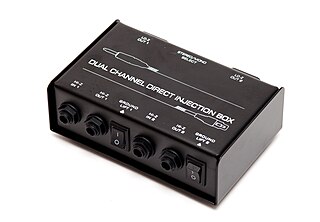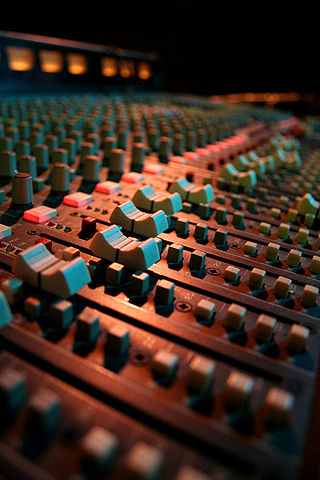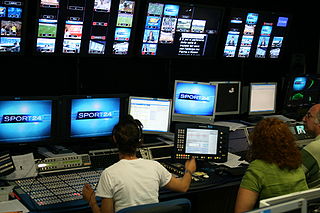
A mixing console or mixing desk is an electronic device for mixing audio signals, used in sound recording and reproduction and sound reinforcement systems. Inputs to the console include microphones, signals from electric or electronic instruments, or recorded sounds. Mixers may control analog or digital signals. The modified signals are summed to produce the combined output signals, which can then be broadcast, amplified through a sound reinforcement system or recorded.

A DI unit is an electronic device typically used in recording studios and in sound reinforcement systems to connect a high output impedance unbalanced output signal to a low-impedance, microphone level, balanced input, usually via an XLR connector and XLR cable. DIs are frequently used to connect an electric guitar or electric bass to a mixing console's microphone input jack. The DI performs level matching, balancing, and either active buffering or passive impedance matching/impedance bridging. DI units are typically metal boxes with input and output jacks and, for more expensive units, “ground lift” and attenuator switches.
A technical director (TD) is usually a senior technical person within e.g. a software company, engineering firm, film studio, theatre company or television studio. This person usually has the highest level of skill within a specific technical field.

In audio engineering, a fade is a gradual increase or decrease in the level of an audio signal. The term can also be used for film cinematography or theatre lighting in much the same way.

A vision mixer is a device used to select between several different live video sources and, in some cases, compositing live video sources together to create visual effects.

The production control room (PCR) or studio control room (SCR) is the place in a television studio in which the composition of the outgoing program takes place.

A character generator, often abbreviated as CG, is a device or software that produces static or animated text for keying into a video stream. Modern character generators are computer-based, and they can generate graphics as well as text.

Teletext, or broadcast teletext, is a standard for displaying text and rudimentary graphics on suitably equipped television sets. Teletext sends data in the broadcast signal, hidden in the invisible vertical blanking interval area at the top and bottom of the screen. The teletext decoder in the television buffers this information as a series of "pages", each given a number. The user can display chosen pages using their remote control. In broad terms, it can be considered as Videotex, a system for the delivery of information to a user in a computer-like format, typically displayed on a television or a dumb terminal, but that designation is usually reserved for systems that provide bi-directional communication, such as Prestel or Minitel.

A DJ mixer is a type of audio mixing console used by disc jockeys (DJs) to control and manipulate multiple audio signals. Some DJs use the mixer to make seamless transitions from one song to another when they are playing records at a dance club. Hip hop DJs and turntablists use the DJ mixer to play record players like a musical instrument and create new sounds. DJs in the disco, house music, electronic dance music and other dance-oriented genres use the mixer to make smooth transitions between different sound recordings as they are playing. The sources are typically record turntables, compact cassettes, CDJs, or DJ software on a laptop. DJ mixers allow the DJ to use headphones to preview the next song before playing it to the audience. Most low- to mid-priced DJ mixers can only accommodate two turntables or CD players, but some mixers can accommodate up to four turntables or CD players. DJs and turntablists in hip hop music and nu metal use DJ mixers to create beats, loops and so-called scratching sound effects.
A radio transmitter or just transmitter is an electronic device which produces radio waves with an antenna. Radio waves are electromagnetic waves with frequencies between about 30 Hz and 300 GHz. The transmitter itself generates a radio frequency alternating current, which is applied to the antenna. When excited by this alternating current, the antenna radiates radio waves. Transmitters are necessary parts of all systems that use radio: radio and television broadcasting, cell phones, wireless networks, radar, two way radios like walkie talkies, radio navigation systems like GPS, remote entry systems, among numerous other uses.
In broadcasting, channel playout is the generation of the source signal of a radio or television channel produced by a broadcaster, coupled with the transmission of this signal for primary distribution or direct-to-audience distribution via any network. Such radio or television distribution networks include terrestrial broadcasting, cable networks, satellites, IPTV, OTT Video, point-to-point transport over managed networks or the public Internet, etc.

In professional audio, a digital mixing console (DMC) is a type of mixing console used to combine, route, and change the dynamics, equalization and other properties of multiple audio input signals, using digital signal processing rather than analog circuitry. The digital audio samples, which is the internal representation of the analog inputs, are summed to what is known as a master channel to produce a combined output. A professional digital mixing console is a dedicated desk or control surface produced exclusively for the task and is typically more robust in terms of user control, processing power and quality of audio effects. However, a computer can also perform the same function since it can mimic its interface, input and output.

A video wall is a special multi-monitor setup that consists of multiple computer monitors, video projectors, or television sets tiled together contiguously or overlapped in order to form one large screen. Typical display technologies include LCD panels, Direct View LED arrays, blended projection screens, Laser Phosphor Displays, and rear projection cubes. Jumbotron technology was also previously used. Diamond Vision was historically similar to Jumbotron in that they both used cathode-ray tube (CRT) technology, but with slight differences between the two. Early Diamond vision displays used separate flood gun CRTs, one per subpixel. Later Diamond vision displays and all Jumbotrons used field-replaceable modules containing several flood gun CRTs each, one per subpixel, that had common connections shared across all CRTs in a module; the module was connected through a single weather-sealed connector.

A free-to-air or FTA Receiver is a satellite television receiver designed to receive unencrypted broadcasts. Modern decoders are typically compliant with the MPEG-2/DVB-S and more recently the MPEG-4/DVB-S2 standard for digital television, while older FTA receivers relied on analog satellite transmissions which have declined rapidly in recent years.
Apple II graphics debuted on the 1977 Apple II and was used throughout the Apple II line. They consist of a 16 color low resolution mode and a high resolution mode where visuals are dependent on artifact color. The Apple IIe added "double" versions of each of these, most prominently "double high resolution" with twice the horizontal resolution in 16 colors. Internally, Apple II graphics modes are idiosyncratic and do not simply use a linear frame buffer.

An automixer, or automatic microphone mixer, is a live sound mixing device that automatically reduces the strength of a microphone's audio signal when it is not being used. Automixers reduce extraneous noise picked up when several microphones operate simultaneously.

In sound recording and reproduction, audio mixing is the process of optimizing and combining multitrack recordings into a final mono, stereo or surround sound product. In the process of combining the separate tracks, their relative levels are adjusted and balanced and various processes such as equalization and compression are commonly applied to individual tracks, groups of tracks, and the overall mix. In stereo and surround sound mixing, the placement of the tracks within the stereo field are adjusted and balanced. Audio mixing techniques and approaches vary widely and have a significant influence on the final product.
In broadcasting, a transposer or translator is a device in or beyond the service area of a radio or television station transmitter that rebroadcasts signals to receivers which can’t properly receive the signals of the transmitter because of a physical obstruction. A translator receives the signals of the transmitter and rebroadcasts the signals to the area of poor reception. Sometimes the translator is also called a relay transmitter, rebroadcast transmitter or transposer. Since translators are used to cover a small shadowed area, their output powers are usually lower than that of the radio or television station transmitters feeding them.

A television production truck or OB van is a small mobile production control room to allow filming of events and video production at locations outside a regular television studio. They are used for remote broadcasts, outside broadcasting (OB), and electronic field production (EFP). Some require a crew of as many as 30 people, with additional trucks for additional equipment as well as a satellite truck, which transmits video back to the studio by sending it up through a communications satellite using a satellite dish, which then transmits it back down to the studio. Alternatively, some production trucks include a satellite transmitter and satellite dish for this purpose in a single truck body to save space, time and cost.

vMix is a software vision mixer available for the Windows operating system. The software is developed by StudioCoast PTY LTD. Like most vision mixing software, it allows users to switch inputs, mix audio, record outputs, and live stream cameras, videos files, audio, and more, in resolutions of up to 4K. The software is also capable of serving image magnification (IMAG) and projection needs in many instances, with various configurable external output and display options.















